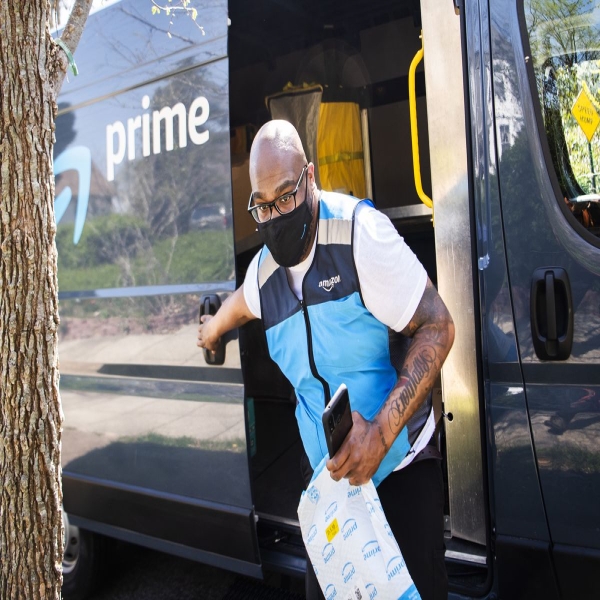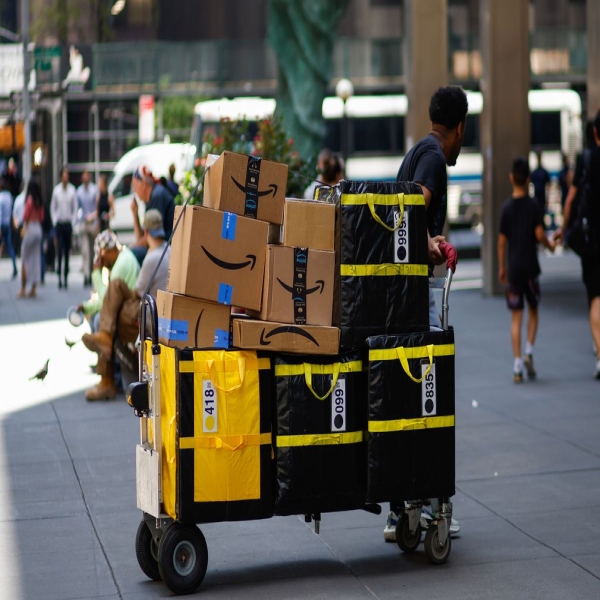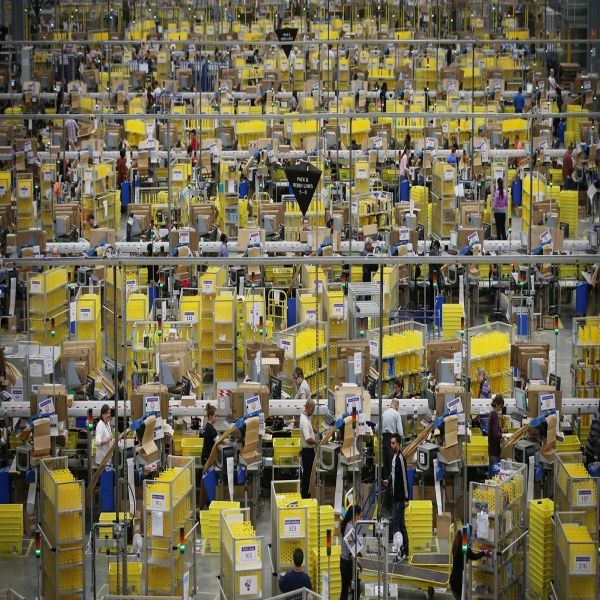Why the FTC is going after your Prime subscription (and a few other things).

The Big Tech antitrust reform movement has come for Amazon. On September 26, the Federal Trade Commission and 17 states sued the Everything Store for “illegally maintaining monopoly power.” This comes after two different antitrust lawsuits against Google from the Department of Justice — one of which is currently on trial — and another one against Meta from the FTC.
Like the others, this lawsuit gets at the heart of some of the defendant’s business practices and how they work in concert to reinforce its dominance. In this case, Amazon is accused of using its monopoly on online shopping to make it impossible for other platforms to compete; force the many companies that sell products through Amazon to pay various fees and follow rules designed to enrich Amazon and disadvantage everyone else; and inflate prices on Amazon and beyond. Something called “Project Nessie” is thrown in there, too.
It will be years before the case goes to trial and even longer before we get a final resolution, assuming it isn’t dropped or settled first, so we’re only at the beginning of a long process. If the FTC wins, Amazon may be forced to do business differently or even be broken up. That might mean some changes to how you shop, too. If you’re wondering what exactly Amazon is accused of doing wrong and how all of this could affect you, we have some answers.
1) Why is the FTC suing Amazon?
The FTC is accusing Amazon of abusing its monopoly, harming competition, businesses that sell products through Amazon’s platform, and consumers. (The FTC is one of two agencies that enforces antitrust laws in the US. The other is the Department of Justice, which has its own Big Tech antitrust cases to fight.)
The FTC’s main argument targets Amazon Marketplace, where outside businesses, or third-party sellers, sell their products to Amazon customers. This platform has vastly increased the number of products Amazon can offer to consumers and accounts for the majority of Amazon’s sales. And Amazon, the FTC says, has implemented various rules and fees that sellers have no choice but to follow and pay. That has enriched Amazon at the expense of the sellers and consumers, who are paying inflated prices not just on Amazon but everywhere else, too. —Sara Morrison
2) What? How could I be paying higher prices on Amazon, a company that famously offers the lowest prices?
The FTC’s case is that the low prices on Amazon are a mirage, and the company is using several interconnected business lines to create it. There are two parts to this.
The first is that Amazon knows it has tremendous leverage over third-party businesses, whose survival depends on being allowed on the platform and having visibility to their customers. Over time, it has implemented rules and fees that sellers feel compelled to follow and pay. Those include search ads, commissions on sales, and using Amazon’s warehouses and shipping services.
Amazon has put more and more ads on search results pages, which means sellers feel compelled to buy ads if they want to get in front of customers. It has also made Prime an integral part of the shopping and selling experience. Lots of customers have Prime, so they look for products sold through Prime to save on shipping and get their subscription money’s worth. Amazon gives Prime products much more prominent placement on product pages, so sellers have to qualify for Prime if they want people to see and buy their products. But Amazon also makes sellers use its warehouse and shipping service, Fulfillment by Amazon, to qualify for Prime. This has resulted in sellers paying as much as 50 cents on every dollar in sales to Amazon, the suit says. To maintain their profit margin or make any profit at all, sellers have to pass those costs onto consumers.
But here’s the second part of all this: Amazon’s “fair pricing” policies say that sellers can’t really offer their products for less anywhere else. Sellers are afraid to run afoul of Amazon, which could mean their listings are suppressed or they’re kicked off the platform entirely. So even if a seller incurred fewer expenses and could price their products for less and maintain the same profit margin on another platform, they won’t.
The lawsuit also alleges Amazon makes it difficult for first-party sellers, or retailers that sell products to Amazon that Amazon then sells to consumers, to offer lower prices elsewhere. But it’s less clear how Amazon is allegedly doing this, as those sections are heavily redacted.

All these factors combined, the lawsuit says, mean that customers are paying more everywhere, sellers are being squeezed, other stores can’t compete with Amazon on prices, and Amazon doesn’t have to lower the various fees it charges sellers.
So while Amazon may have the lowest prices out there, those aren’t necessarily the lowest prices possible. —SM
3) What does Amazon say about all this?
David Zapolsky, Amazon’s general counsel and senior vice president of global public policy, released a statement in response to the FTC lawsuit, calling the suit “misguided” and arguing that, if successful, the lawsuit would increase prices, lead to slower deliveries, and hurt the small businesses that use Amazon Marketplace.
The statement responds to a couple of the FTC complaint’s arguments directly. One repeated theme throughout Amazon’s response is this: While Amazon might encourage sellers to, say, sign up for their Fulfillment by Amazon service or create listings that meet certain conditions in order to be prominently featured, they don’t actually require sellers to do any of those things in order to list there. And, they argue, giving merchants multiple ways to sell on Amazon increases competition and is good for businesses.
Amazon also argues that the FTC’s characterization of Amazon’s market share is too large because it doesn’t include physical retail stores as competition. —A.W. Ohlheiser
4) Who is Lina Khan and why does she matter?
Lina Khan is the current FTC chair, a position she’s held since 2021. As Vox has previously explained, Khan was best known at the time of her appointment for her law school paper titled “Amazon’s Antitrust Paradox,” and was a prominent advocate for antitrust reform who was known, specifically, for criticizing Amazon’s business practices.
If you’re wondering how Amazon feels about Khan’s tenure as FTC chair, well … after Khan’s appointment, Amazon petitioned the FTC with a complaint, arguing that Khan should recuse herself from participating in any actions that regulate Amazon as a company due to her past criticism. —AO

5) What is “Project Nessie?” I love cryptozoology, so how can something that sounds so cool be bad?
Details about Project Nessie, which is mentioned several times in the complaint, were mostly redacted, other than the fact that it was some kind of algorithm.
According to subsequent reporting from the Wall Street Journal, lurking just below the surface of those redactions were allegations that Amazon was using this algorithm to test how much it could raise prices on items and have competitors follow suit, thereby maximizing Amazon’s profit and inflating prices for consumers everywhere.
A recent book about Amazon written by former Vox reporter Jason Del Rey quoted a company spokesperson who described Project Nessie as an algorithm designed to avoid price-matching competitors when they went too low, thereby avoiding a price-matching “death spiral.” When the company found it wasn’t increasing its own profits, the project ended.
That aligns with Amazon’s explanation of the tool, which it released in a statement following the WSJ report. Amazon says the FTC’s allegations “grossly mischaracterize” Project Nessie, adding:
Project Nessie was a project with a simple purpose — to try to stop our price matching from resulting in unusual outcomes where prices became so low that they were unsustainable. The project ran for a few years on a subset of products, but didn’t work as intended, so we scrapped it several years ago.
While it remains partially shrouded in mystery, we may get more details in the weeks to come as Amazon will have to justify these redactions to a judge, who will ultimately decide what should be kept from the public. —SM
6) What does “Fulfillment by Amazon” mean? And what the heck is a “buy box?”
As the lawsuit indicates, there are a couple of different ways products are sold on Amazon. There are things sold and shipped by Amazon — whether they are products produced under an Amazon brand or purchased wholesale by Amazon from another company — and there are products sold by third parties through Amazon Marketplace.
Third-party sellers are exactly what you might guess: people or businesses that are not directly affiliated with Amazon using the retail site’s enormous platform to sell their products. Generally, third-party sellers control their own listings. Some third-party merchants on Amazon ship their products directly to customers. Others tap into Amazon’s infrastructure a little more deeply.
Enter the Fulfillment by Amazon service, where sellers can, for a fee, send their inventory directly to an Amazon warehouse and let Amazon process and ship the order. These products are generally eligible for Prime shipping. (It’s exceedingly difficult to get Prime shipping without using Fulfillment by Amazon.)
Being a third-party seller on Amazon doesn’t necessarily mean that your products will be visible to a wide audience of Amazon shoppers. Amazon encourages sellers to list their products in specific ways in order to maximize visibility. For instance: Third-party sellers who list the same item for purchase in Amazon Marketplace are competing with each other to show up in the “buy box” (also called the “featured offer”). The buy box is the box on an Amazon listing that contains the “add to cart” and “buy now” buttons, a.k.a. where you are generally going to click as a consumer if you want to buy the product.
In Amazon’s guide to getting a product featured in the buy box, it encourages sellers to price “competitively” or “at or below the lowest priced alternatives,” and to offer “fast and free shipping,” either through their own merchant shipping process or by signing up for the Fulfilled by Amazon service. A product is also more likely to show up in the buy box if it’s eligible for Prime shipping. —AO
7) Why should I care what Amazon does to third-party sellers?
It’s important to remember that Marketplace sales account for the majority of sales on Amazon and that these third-party sellers are paying fees to Amazon in order to sell there. Signing up for Fulfillment by Amazon comes with additional costs to the merchant. When Amazon raises those fees, consumers will generally have to pay more for that item going forward.
Amazon’s policies can also raise the prices of items on other sites. Because the company’s fair pricing policy gives them leeway to punish merchants who list a product on Amazon at a higher price than they might elsewhere — say, on a platform that does not charge the same fees Amazon does — sellers are incentivized to raise their prices everywhere in order to account for Amazon’s fees. —AO

8) What will happen to Amazon if it loses the FTC lawsuit? How will it affect me?
In interviews with the press, Khan has been careful not to say much about what remedies the FTC will pursue if it wins the case. But the agency is asking the court to stop Amazon from engaging in illegal practices, issue monetary penalties, and provide any relief necessary to prevent Amazon from violating the law again in the future — up to structural relief, which means breaking the company up.
That doesn’t mean that an FTC win will break up Amazon, and we don’t know what that breakup would look like even if it did. A judge would make that decision, and we’re a long way away from even the possibility of it. The fact that the FTC played up the interconnected and interlocking nature of Amazon’s alleged violations in its complaint, though, indicates that the agency would say there’s no way to truly solve the problem if the company remains in one piece.
This also means it’s impossible to say, right now, how things would change for you, the customer. If Amazon isn’t broken up, it may well have to stop or significantly change its Prime service, which is one of the alleged weapons Amazon wields over sellers. The FTC will say that an agency victory will mean lower prices for you and more competition that will force Amazon to have to offer a better product or give you more or better shopping options elsewhere. The very fact that Amazon is now fighting a lawsuit could have a chilling effect on some of the ways it does (or wants to do) business, as was the case for Microsoft in the late ’90s and early ’00s. That said, Amazon isn’t going to do anything drastic unless it absolutely has to. —SM
9) But will Amazon lose? I mean, come on. Really?
We here at Vox don’t have a crystal ball, but history shows that antitrust cases are hard to win. Courts are business-friendly and have only become more so since the last Big Tech antitrust case against Microsoft. Khan’s FTC has had some high-profile losses with Big Tech so far. But those were about acquisitions and not, as this case is about, existing business practices.
This case does have something other cases against Meta and Google don’t: physical goods that, the FTC says, consumers are paying more for than they should. That’s something that courts, which have come to embrace the “consumer welfare standard” as a deciding factor in whether or not a company’s monopoly is harmful, will pay attention to. That still doesn’t mean the FTC will be able to convince them that Amazon is doing anything wrong. —SM
Source: vox.com






